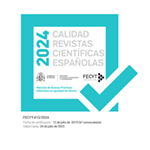Visibility and surveillance regime in the age of Digital Identity
Abstract
This article addresses the link between the hypervisibility regime in which the contemporary subject is immersed in and the new forms of surveillance. Based on an analysis of the work of Hito Steyerl How Not to be Seen: A Fucking Didactic Educational .MOV File (2013) we explore the changes suffered by the traditional form of surveillance with a special highlight on the current features of the cyber-surveillance device. The 21st century is witnessing a socio-technical phenomenon which transforms the subject into an image-data, as a result of what Paul Virilio calls the industrialization and proliferation of “visual machines” (photographic cameras, microscopes, telescopes, drones), the social online habits which tend to self-capture and self-diffusion, and the processes of datification. Nowadays, the subject assumes an active role in the surveillance mechanisms and, hence, is partly responsible of the control that is practiced over him. In this video, Hito Steyerl teaches us about camouflage techniques, confusion and low resolution uses, in order to be less visible before the eyes of the power. However, the excess of visibility and exposure of the subject seems to be a highly difficult situation to counteract in the technical conditions that we live in. As we propose in the last section of the article, in order to solve the surveillance problems in the digital age it is necessary to redefine the concept of privacy starting from the concept of digital identity, with all its implications. Consequently, we must lead the way into new forms of legal authority over data.Downloads
Publication Facts
Reviewer profiles N/A
Author statements
- Academic society
- N/A
- Publisher
- Grupo de Investigación Cultura Digital y Movimientos Sociales. Cibersomosaguas
Article download
License
In order to support the global exchange of knowledge, the journal Teknokultura is allowing unrestricted access to its content as from its publication in this electronic edition, and as such it is an open-access journal. The originals published in this journal are the property of the Complutense University of Madrid and any reproduction thereof in full or in part must cite the source. All content is distributed under a Creative Commons Attribution 4.0 use and distribution licence (CC BY 4.0). This circumstance must be expressly stated in these terms where necessary. You can view the summary and the complete legal text of the licence.













